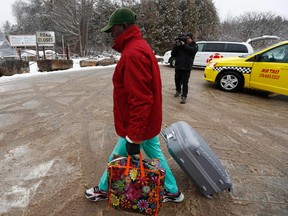
Article content
Canadian cities are being overwhelmed by a record surge of newcomers seeking asylum, straining their budgets and pushing temporary shelters beyond their limits.
Advertisement 2
Article content
In Peel, a suburban region in greater Toronto, the shelter system is running at 300% of capacity, with asylum-seekers occupying more than 70% of the beds and many more camping on the streets, according to Patrick Brown, the mayor of Brampton.
Article content
“It’s an ugly situation. If Canada’s going to allow more asylum claimants into our country, we need to make sure that they’re not left abandoned, and frankly, what we’ve seen is too much of that,” said Brown, whose city of almost 700,000 people is not far from Toronto Pearson, the country’s busiest airport.
Brampton’s stress is a microcosm of Canada’s struggle to cope with rapid increases in the number of immigrants seeking refuge. Shelter systems in Montreal, Ottawa and Vancouver are also over capacity — exacerbating a shortage of available places for the homeless population.
Article content
Advertisement 3
Article content
A rise in asylum claimants has become a major political issue across many countries, including the U.S., where cities such as New York and Chicago are grappling with how to manage the waves of migrants who’ve traveled across the southern border. Although Canada’s geography means it sees a fraction as many irregular border crossings as the U.S., there’s been an increase in the numbers arriving by air — particularly from Mexico.
The influx has prompted Prime Minister Justin Trudeau’s government to make policy shifts. Last year, Trudeau and U.S. President Joe Biden agreed to end a pact that had resulted in asylum-seekers crossing into Canada from the U.S. at a location known as Roxham Road. Then, in February, Trudeau’s government reimposed visa rules for many Mexican citizens.
Advertisement 4
Article content
And last month, Canada said it plans to reduce the size of its temporary resident population, a group that includes asylum claimants and foreigners on temporary work permits.
Mexico is by far the largest source country for those seeking asylum in Canada, followed by Haiti, Turkey, India and Colombia. In Brampton, about 80% came from five African countries, including Kenya and Nigeria, Brown said.
The numbers have risen because of the overlapping conflicts and crises in other nations, the resumption of international travel after the pandemic and Canada’s broadening of the legal basis for asylum claims.
Trudeau’s government — under pressure from Quebec Premier Francois Legault and Toronto Mayor Olivia Chow — offered about $360 million in January to provinces and cities to help deal with “extraordinary interim housing pressures” from asylum claimants. It says it’s transferred about $750 million to other levels of government since 2017 to help with asylum-related housing costs.
Advertisement 5
Article content
Still, Brown’s contention is that the national government hasn’t done enough. Last year, his region had a shortfall of more than $20 million to care for them and the mayor projects that to triple this year.
“If we’re going to be a country that offers safe harbour to those fleeing adversity, they can’t be left out in the frigid cold in that process,” Brown said.
Student Population
The rapid growth in asylum seekers in Canada is happening in tandem with record population gains, driven by foreign workers and international students. But frustration over housing shortages has forced Trudeau’s government to scale back on its immigration ambitions in recent months — among other things, it’s capping the number of foreign-study permits.
Advertisement 6
Article content
Brampton is also a focal point of colleges trying to cash in on the demand from those international students, many of whom see higher education as a pathway to settling in Canada. The number of international students in the country has tripled to around 1 million in less than a decade.
Many of the new arrivals faced soaring rents and lack of part-time jobs, and some, according to Brown, are “living in unfortunate conditions — sometimes in encampments, sometimes 25 students in a basement apartment.” Some asylum seekers in Brampton also live in a “large encampment outside the shelter system itself,” Brown said. Prior to the surge that started around mid-2023, asylum claimants took up just 2% of local shelter beds, he said.
“It’s put a significant cost barrier on cities. Cities have never funded this before,” Brown said. Under Ontario law, local governments can’t run budget deficits to pay for such unexpected costs. “So if you have people living on the sidewalk, that means you either have to take it from your public transit fund, your police fund, your paramedic fund, it’s just a negative cycle. We’re hoping it doesn’t get to that.”
Article content



